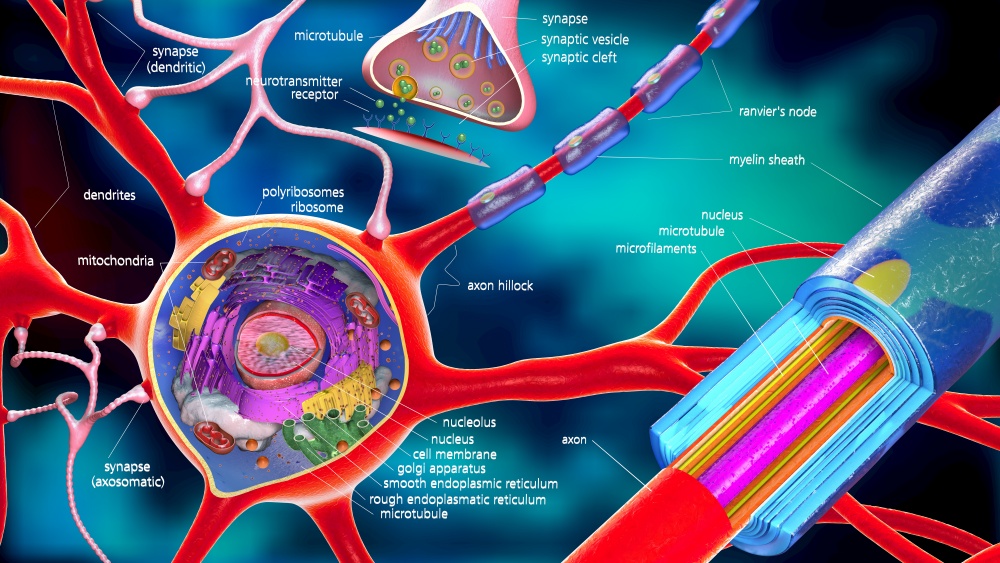Within every cell of the human body is a pool of structures called mitochondria, often referred to as the “powerhouse” of the cell (generating 90% of the body’s energy). In recent years mitochondria have been credited for brain health and optimal performance.
On the other hand, mitochondrial dysfunction has been linked to a number of degenerative diseases including multiple sclerosis, Parkinson’s disease, ALS, and Alzheimer’s disease. In addition to degenerative diseases, mitochondrial dysfunction has been associated with diabetes, depression, anxiety, obesity, and ADHD. As well as age-related impairments including memory, vision, hearing, attention, and cognition.
With that said, in this article, we are going to do a deep dive into the structure and function of this critical structure.
What are mitochondria?
Mitochondria are oval-shaped structures (organelles) located within every cell in the human body. The main function of these oval-shaped structures is to produce energy.
Mitochondria are the energy producers of the cell
Glucose enters the cell and is broken down before it enters the mitochondria. Once inside the mitochondria, the dismembered glucose molecule is converted into energy called adenosine triphosphate (ATP). This process is called oxidative phosphorylation (OXPHOS).
Fatty acids are also converted to ATP in the mitochondria via the same process but do not need to be broken down before entering the mitochondria.
Oxidative phosphorylation (OXPHOS) is responsible for powering almost every cellular operation including muscle contraction (movement) and brain function.
The number of mitochondria within each cell varies depending on the energy requirements. For example, nerve cells (neurons) in the brain have a high concentration of mitochondria given the high energy requirement of brain tissue.
Reactive Oxygen Species: A byproduct of energy production
During this “energy-making process”, mitochondria release reactive oxygen species (ROS), a type of free radical. ROS is an unstable molecule with one unpaired electron. To become a stable molecule ROS must either steal an electron or give one away thus making another molecule unstable. In excess, ROS has the potential to cause damage. To prevent ROS from damaging the cell, there is something called the antioxidant defense system. The antioxidant defense system neutralizes these unstable molecules into “non-threatening” molecules. And all is right with the world 😊
Unfortunately, the antioxidant defense system is not limitless in its potential and if too much ROS is produced this can create an imbalance and will result in something called oxidative stress
What is oxidative stress?
Oxidative stress is occurs when the antioxidant defense system is unable to keep up with the production of ROS. This excess production of free radicals (ROS) can damage the cell’s DNA, lipids, and proteins. Oxidative stress also creates problems in the mitochondria causing less energy (ATP) production and overproducing ROS. I liken this to an old car where the car becomes “less efficient” and produces more exhaust.
Hence, oxidative stress is implicated in a variety of diseases.
Other mitochondrial functions
In addition to producing energy, mitochondria store calcium for cell signaling, generate heat, and mediate cell growth and death.
How do mitochondria maintain optimal performance and brain health?
Given the importance of mitochondria on cellular operations, there are mechanisms in place to ensure these vital structures are functioning at full capacity. The 3 processes are called fission, fusion, and mitochondrial biogenesis (making new mitochondria).
When a part of a mitochondria becomes weak or damaged, that part of the mitochondria is cut off and disposed. This process is called fission.
When a mitochondrion is “slowing down” or becoming less efficient, it will join another “aging mitochondria” through a process called fusion.
And no mitochondria will live forever and therefore, there is a process of creating new mitochondria called mitochondrial biogenesis.
Individuals with higher concentration of mitochondria have more energy and are overall healthier. For example, children have an extremely high concentration of mitochondria and are typically bundles of energy. On the other hand, older adults have fewer mitochondria, less energy, and higher prevalence of disease.
You may also be interested in one of these articles:
Suboptimal Coping Strategies…
Control is an alluring coping strategy in challenging times. I credit most of my upper body strength to Chico. My workout includes rows, bicep curls, arm rotation, trunk rotation and occasional back extension. I do this workout about 3-4 times a day. It is brutal....
Here for a season….
Fear and faith can’t co-exist. Why are we not where we want to be? Why are you not where you want to be? Have you ever set out to accomplish a goal and gave up long before the finish line? Or maybe you accomplished a goal, only to return to your baseline. If so, you...
Love, generativity, and wisdom after a health crisis
"He gives strength to the weary and increases the power of the weak. Even youths grow tired and weary, and young men stumble and fall; but those who hope in the LORD will renew their strength. They will soar on wings like eagles; they will run and not grow weary, they...
Trees, chainsaws, and pain
“I have told you these things, so that in me you may have peace. In this world you will have trouble. But take heart! I have overcome the world.” – Jesus John 16:33 NIV “Pain is temporary”. Or so they say. I would like to poke a thousand holes into this idea. Full...
You aren’t as lazy as you think…
“You can’t teach an old dog new tricks”. My 15-year-old car recently had to be admitted to the car hospital to infuse anything possible into its worn body as somewhat of a “Hail Mary” to extend its life. After getting her admitted I am not going to lie when I say I...
The Quality of Life Jackpot
“Quality of life (QOL)” is one’s perceived “position” in life and is a meaningful metric to “manipulate” in the pursuit of happiness. Some “work” to manipulate this by building relationships, wealth, or a family. All of which will undoubtedly have the potential to...
Post Traumatic Growth
"All life demands struggle. Those who have everything given to them become lazy, selfish, and insensitive to the real values of life. The very striving and hard work that we so constantly try to avoid is the major building block in the person we are today." Pope Paul...
Timelessness is a real thing
"Patience is not passive resignation, nor is it failing to act because of our fears. Patience means active waiting and enduring. It means staying with something and doing all that we can – working, hoping, and exercising faith; bearing hardship with fortitude, even...
Productivity or……profit
“The plans of the diligent lead to profit as surely as haste leads to poverty.” Proverbs 21:5 I can’t count on both hands the number of times someone asks me for “a number”. “Just tell me how many times a day I need to do this exercise, and I will do it.” The question...
Confinement….And Freedom
“Authentic freedom is actually the freedom of knowing who you are, why you are here, your purpose in life and where you are going when you leave here.” – Wayne Dyer Confinement. A word (in it’s various forms) used to describe someone with a physical limitation. “She...











